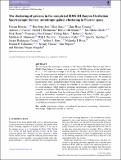The clustering of galaxies in the completed SDSS-III Baryon Oscillation Spectroscopic Survey : anisotropic galaxy clustering in Fourier space
Abstract
We investigate the anisotropic clustering of the Baryon Oscillation Spectroscopic Survey (BOSS) Data Release 12 sample, which consists of 1198 006 galaxies in the redshift range 0.2 < z < 0.75 and a sky coverage of 10 252 deg2. We analyse this data set in Fourier space, using the power-spectrum multipoles to measure redshift-space distortions simultaneously with the Alcock–Paczynski effect and the baryon acoustic oscillation scale. We include the power-spectrum monopole, quadrupole and hexadecapole in our analysis and compare our measurements with a perturbation-theory-based model, while properly accounting for the survey window function. To evaluate the reliability of our analysis pipeline, we participate in a mock challenge, which results in systematic uncertainties significantly smaller than the statistical uncertainties. While the high-redshift constraint on fσ8 at zeff = 0.61 indicates a small (∼1.4σ) deviation from the prediction of the Planck ΛCDM (Λ cold dark matter) model, the low-redshift constraint is in good agreement with Planck ΛCDM. This paper is part of a set that analyses the final galaxy clustering data set from BOSS. The measurements and likelihoods presented here are combined with others in Alam et al. to produce the final cosmological constraints from BOSS.
Citation
Beutler , F , Seo , H-J , Saito , S , Chuang , C-H , Cuesta , A J , Eisenstein , D J , Gil-Marín , H , Grieb , J N , Hand , N , Kitaura , F-S , Modi , C , Nichol , R C , Olmstead , M D , Percival , W J , Prada , F , Sánchez , A G , Rodriguez-Torres , S , Ross , A J , Ross , N P , Schneider , D P , Tinker , J , Tojeiro , R & Vargas-Magaña , M 2017 , ' The clustering of galaxies in the completed SDSS-III Baryon Oscillation Spectroscopic Survey : anisotropic galaxy clustering in Fourier space ' , Monthly Notices of the Royal Astronomical Society , vol. 466 , no. 2 , pp. 2242-2260 . https://doi.org/10.1093/mnras/stw3298
Publication
Monthly Notices of the Royal Astronomical Society
Status
Peer reviewed
ISSN
0035-8711Type
Journal article
Collections
Items in the St Andrews Research Repository are protected by copyright, with all rights reserved, unless otherwise indicated.

